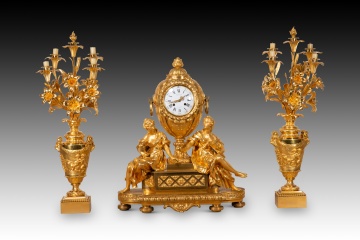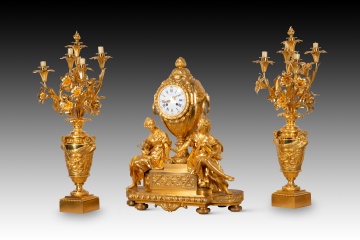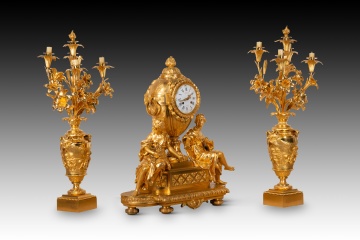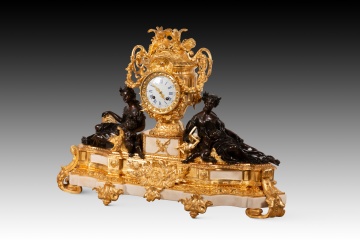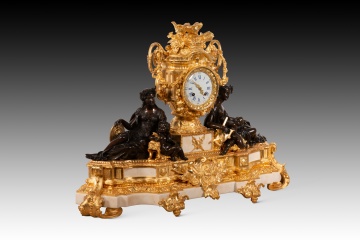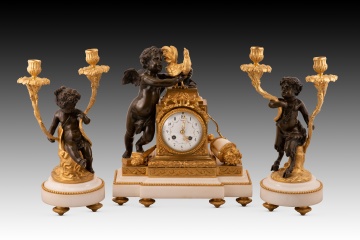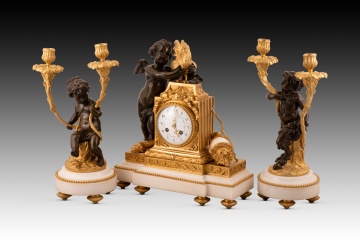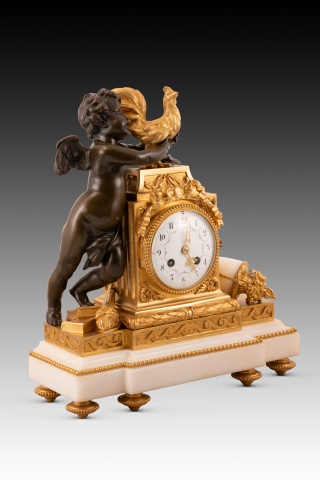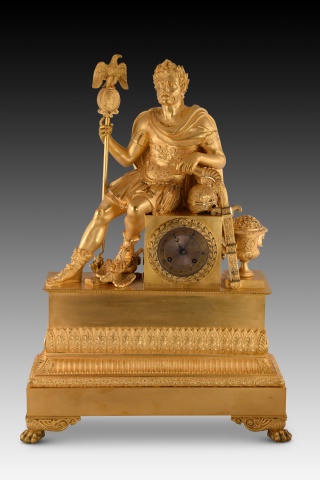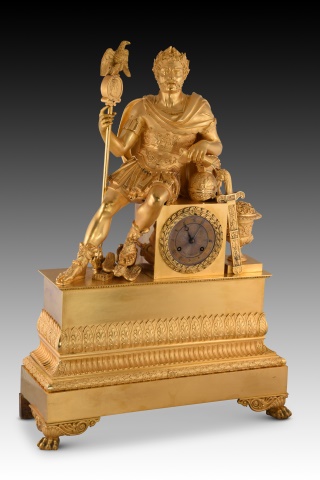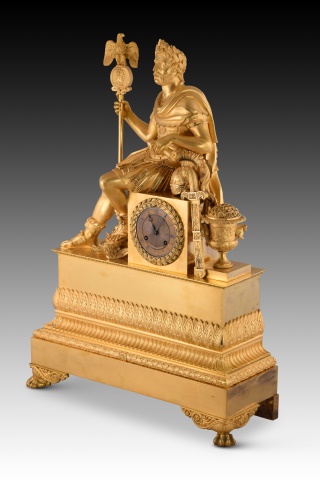
Results 1 to 22 of 22
«« « 1 » »»
-
MANTEL CLOCK. BRONZE, MARBLE. MODEL FROM LENOIR-RAVRIO, LOUIS-SATINSLA...
Table clock, Apollo. Bronze, marble. Model by LENOIR-RAVRIO, Louis-Stanislas (1783-1846). Paris, circa 1820. Table clock consisting of a stepped rectangular base made of red veined marble and gilt bronze elements with a clear classicist influence (molding of architectural motifs, set of garlands and elements linked with latticework), and the area of the clock face, situated on a stepped pedestal, placing, on it, a patinated bronze figure representing the god Apollo (note the gilt bronze lyre he holds in one hand). The dial, made of gilt bronze with different finishes, has Roman numerals, Breguet-type hands, and the inscription “L. RAVRIO BRONZIER / A PARIS”, relating to the creator of the bronzes in the work. Louis-Stanislas Lenoir-Ravrio (Paris, 1783 – Ivry, 1846), adopted son of André-Antoine Ravrio (1759-1814), was one of the leading bronze makers of his time (his father was also one), and they worked together for a number of years (until 1814). He officially joined his father's business in 1811, gaining great recognition for his works at the Garde-Meuble and for his participation in International and National Exhibitions. Weight: 28 kgANTIQUES
· Size: 43x16x62 cms.
Ref.: ZE345 -
CLOCK SET. PORCELAIN AND GILT BRONZE. FRANCE, 19TH CENTURY.
Clock and candlesticks in porcelain and gilt bronze. France, 19th century. Mechanism in perfect working order. Mantelpiece consisting of a clock and two five-light candelabra, all three pieces made from a combination of gilt bronze, with raised and rounded elements and cold-chiseled details, and porcelain decorated with low-temperature enamels, including gilt enamel. The porcelain pieces follow 18th-century models from the Sèvres National Manufactory, with large pictorial cartouches on a cobalt blue background decorated with gilded plant motifs. The ensemble follows a historicist design that combines baroque and neoclassical elements with Rococo-inspired enamelled scenes, depicting landscapes and scenes with mythological themes alluding to the arts and the goddess Venus. The clock mechanism is stamped “Chles. MT”, with serial number 17420. The main enamelled porcelain plates are signed DP Boncher. The clock follows an architectural structure, with an oval base with a prominent front on the ground plan, raised on four moulded feet in the shape of a top, on which a large ornamental vase is placed. This base has a distinct pinto and, above it, a main body like a façade, with a circular pediment that houses the clock face. This includes black enamelled Roman numerals on white medallions with a gold border, arranged around the central representation of a cupid reclining among clouds, holding a floral garland and accompanied by musical instruments. Between the medallions that house the numbers, a small jewelled decoration evoking pearls and inlaid rubies, which is echoed in the secondary areas of the body of the piece and also of the vase, always combined with delicate gold filigree. On either side of the face are two female portraits of 18th century ladies, in oval frames. Below, a classically inspired scene with a muse holding musical instruments, probably Euterpe or Erato, accompanied by a cupid reading a score. On the sides of the clock body, two large curved rectangular plaques house highly pictorial enamelled landscapes, worked with the same miniaturist precision as the rest of the enamelled cartouches. These are landscapes of romantic heritage, again inspired by the 18th century, with ideal twilight-like settings, featuring classical ruins. The vase that tops the clock body has a hemispherical tank, shoulders ending in a ridge, an openwork truncated conical neck that opens gently towards the shoulders, and a domed lid, also openwork. The handles are figurative, in bronze, with two female herms crowned with flowers, clearly inspired by Greco-Latin, worked in the round. The vase houses two enamelled porcelain cartouches on the top, the front with two cupids and a dove – a symbolic allusion to Venus – and the back with musical instruments. The clock design is completed by two thick S-shaped plant supports in bronze, under the vase, and counter mouldings and plant motifs cast in relief and cold-chiselled, combining a matt and polished finish. The candelabra follow a similar design, with large neoclassical vases on pedestals, in this case cylindrical, raised on four low turned feet. The bases house porcelain cartouches with scenes of cupids related to the arts; one shows two cupids practising painting, and the other two in a scene related to classical lyric poetry, with one putto writing while the other, holding a lyre, raises a laurel wreath above his head. The cartouches on the front of the candelabra vases show scenes of Venus and Cupid in ideal landscape settings, one of them with a background of classical ruins. As with the clock, the candelabra vases include figurative bronze handles, in this case with rams' heads. The lighting body of both pieces includes four bronze arms based on vegetal braces, finished with cylindrical porcelain burners, with the fifth highest burner standing out, crowning the central axis.ANTIQUES
· Size: Reloj: 42x60x65 cms. Candelabros: 20x20x62,5 cms.
Ref.: ZF1226 -
GARNITURE. GILT BRONZE. HENRI PICARD, VICTOR PAILLARD. PARIS, FRANCE, ...
Garrison, clock, and two candlesticks. Gilt bronze. Henri Picard and Victor Paillard. Paris, France, 1831–1864. With marks (base, back). Gilt bronze fittings composed of a clock and two four-light candelabras each, accompanied by flowers, with plain bases and vase-shaped feet of strong Classicist inspiration, decorated with reliefs (fauns, children's figures, garlands, grotesque heads, etc.). The clock has two female figures (allegories of Geography and Astronomy due to the objects they carry) flanking a vase containing the dial, which features Roman numerals for the hours and Arabic numerals every five minutes, in addition to the signature. The Paris-type movement features an engraved number and a stamp (Vr. Paillard / A. Paris). On the base of the clock, on the back, is engraved the legend H. Picard, referring to the founder and gilder Henri Picard (France, active 1831–1864), who worked for Defreveille and also collaborated with Charles Perrault and Grault. He produced numerous works for Napoleon III, many of which are preserved in the Louvre Museum in Paris. The dial reads "Victor Paillard / Ft de Bronzes / A Paris". Victor Paillard (1805-1886) was a French sculptor who furthered his training in Paris with Jean-François Denière, also collaborating with Ferdinand Barbedienne. In 1830, he founded a successful firm of movable art objects, which received state commissions (notably for the Palau d'Afers Exteriors du Quiai d'Orsay). There are records of other clocks like this one: one by the bronze artist Étienne Martincourt with a dial signed "Lepaute à Paris"; another identical to this one, now in the Paul Getty Museum in Malibu (California, USA), from the Tuileries; and yet another with a dial signed by Victor Paillard. As for the model of the vases, they seem to have been inspired by some, truly popular and appreciated, by Claude Michel (Clodion firm), who produced an original in terracotta in 1763, on which numerous pieces in bronze and other materials were based (a pair in marble is kept at the Art Institute of Chicago, dated 1766; in the Goncourt Collection there is one dated 1761 or 1762; a pair of candlesticks with these bases are known, attributed to Barbedienne, etc.). In turn, it seems that Clodion was inspired by some vases by François Boucher. Weight: 57 kg.ANTIQUES
· Size: Reloj 60x27x72 cms Candelabros 32x25x83 cms
MISCELLANEOUS;CLOCKSRef.: ZF1399 -
CLOCK. PALO SANTO (HOLY WOOD), ROSEWOOD, ORMOLU. FRANCE, 19TH CENTURY,...
Clock. Palo santo, rosewood, gilded bronze. France, 19th century, based on the model of Charles Cressent (France, 1685-1768). Grandfather clock with a wooden case that combines palo santo, rosewood and other woods, enhanced with a series of gilded bronze appliqués, which match the curved and counter-curved profiles of the piece. Both the decorative elements and these decorations respond to models of the French Rococo of the 18th century. This piece is inspired by the regulator clock in the royal collections of England, which is located in Buckingham Palace, and was made by Charles Cressent, a master cabinetmaker considered one of the main exponents of French Rococo, although he made pieces in the Regency style and at the beginning of the “rocaille style”. A master sculptor since 1719, he worked as a cabinetmaker and sculptor for the Regent Philip II, Duke of Orleans, and is well known and appreciated for his clocks, chests of drawers, andirons (J. Paul Getty Museum), etc.ANTIQUES
· Size: 81x40x232,5 cms
Ref.: ZE298 -
MANTEL CLOCK. BRONZE, MARBLE. JAPY FRÈRES; BOURSIER. PARIS, FRANCE, CI...
Table clock. Marble, bronze. Japy Freres; Boursier. Paris, France, circa 1849-1854. Machinery in perfect condition and working order. Table clock made of patinated and gilt bronze and marble, featuring a base with architectural and plant elements with a clear Classicist influence, and a panoply in the center. The clock face sits in a vase, flanked by two female figures and two children's figures in patinated bronze. The white dial, with Roman numerals for the hours and Arabic numerals every five minutes, bears the name "Boursier Jne / Elve de Lepautte / À Paris." The Paris-style movement has engraved text and numbers, and a stamp bearing the name Japy Frères, along with the years of the Gold Medals the house received (the last in 1849). The female figures also display clear Classicist influences in their aesthetics, clothing, and objects, recalling allegories from classical mythology. Japy Frédéric (1749-1812) founded the first French watchmaking movement factory in Beaucourt in 1777. Production grew considerably until 1806, when the company began to be called Japy Frères (when the founder's three sons inherited the business). This name was later changed to Japy Frères et Cie in 1854. The dates are assumed by the mention of the medal won in 1849 and the previous nomenclature. There is evidence of a Parisian watchmaker named Boursier who had a workshop on the rue des Vieux Augustins between 1840 and 1860. He signed the dial "Boursier élève de Lepaute". Only prominent private collections and institutions such as the Bank of Spain in Madrid or the BBVA preserve watches from both manufacturers, while from that period and with stylistic similarities are preserved in the National Heritage (Spain), the National Museum of Romanticism, etc. Weight: 35 kg.ANTIQUES
· Size: 80x22x57 cms
Ref.: ZF1168 -
MANTLE CLOCK, MERCURY OR HERMES. BRONZE. PARIS, FRANCE, 19TH CENTURY.
Table clock, Mercury/Hermes. Bronze, metal. Paris, France, ca. 1825. In working order. Movement with engraving (signature). Table clock with a bronze case, combining a gilt finish (base, caduceus, rooster) and a dark blue finish. The pedestal has four legs (with a claw finish and decorated with classicist elements) on which there is a smooth rectangular area, which gives way to a smaller one with a garland of architectural palmettes in slight relief; this second area has a relief decoration resembling a panoply (lyre with tortoiseshell, bows, ivy, cane, etc.). Above is the male figure in blued bronze, sitting sideways on a trunk on which is the dial (metal, Roman numerals for the hours) framed with a snake; next to it is a rooster in a gilt finish. This half-naked young man is Hermes or Mercury, a deity from classical mythology related to commerce, communication, etc., and often known for carrying a caduceus (in his hand, made of gilded bronze) and wings on a helmet or hat with a certain shape (note also present on one foot). The rooster was one of the animals that often accompanied Mercury. There are several known cases very similar to that of the present clock: two by Louis-Sanislas Lenoir-Ravrio (one with a blued figure and a marble base in the Musée de l'Horlogerie in Geneva; another with a gilt bronze figure, in the Royal Pavilion in Brighton - England); one dated around 1825 and attributed to this same master (blued figure but the tree trunk of the dial and other details in gilt bronze; pedestal in a similar composition to the present one) in a private collection; another without attribution in the "bureau du directeur" (General inventory of the cultural heritage of the City of Lyon, France) dated with some doubt to the third quarter of the 19th century, which is very similar to this one. The Paris machinery of the clock has two joined initials engraved on one side and a name in capital letters above the text "a Paris" on the other, alluding to the watchmaker responsible for it. Similar model sold at Sothebys auction 06.07.2011 lot 96. Weight: 21 kg.ANTIQUES
· Size: 43x16x62 cms.
Ref.: ZF0949 -
CLOCK AND CANDELABRA GARNITURE. BRONZE, MARBLE. RAINGO FRÈRES, AARIA, ...
Clock and candelabra trim. Blued and gilded bronze, marble. Raingo Frères, Aaria, Clodion. Paris, France, second half of the 19th century. In operation. A garnish consisting of a table clock and two three-light candelabras each, made of bronze and white marble. The candelabras have legs and a circular base with a gilt bronze band with floral elements, and a child figure in burnished bronze with garlands of vines and grapes on its head, holding branches with roses and leaves, which end in candle holders; they have the name “Clodion” engraved on them. The clock has an elongated base on white marble legs decorated with gilt bronze plaques with figurative scenes (children playing instruments and carrying garlands) and others with plant motifs and lacework. The dial is raised on a pedestal with animal heads, and, on a white background, it has coloured garlands and Arabic numerals for the hours and points and Arabic numerals every fifteen minutes; you can read “Aaria” on it. The piece is crowned by a kneeling faun, in a pensive attitude and pointing to two doves. This central element is flanked by two blued bronze figures of children playing horns. On the Paris machinery it has, you can read a number (448) and “Rango Fres / Paris”. The two candlesticks follow a highly appreciated model in the 19th century of a bronze figure of a bacchante (a common figure in the procession of the classical god Bacchus) made by Claude Michel (1738-Paris, 1814), known as Clodion. This French sculptor, invited to Russia by Catherine II, established a workshop in Paris where he specialised in small-format Rococo mythological sculpture in terracotta, stucco, etc., with such success that his works inspired numerous bronze sculptors to make sculptures, clocks, etc. Raingo Frères was the partnership of the four sons of the Belgian-born watchmaker Zacharie Joseph Raingo (1775-1847), Adolphe, Charles, Denis and Dorsant, formed in 1823. During the 1860s they made important pieces for Napoleon III and his wife, all of which are now housed in the Louvre Museum in Paris. Their well-deserved fame led them to collaborate with leading bronze sculptors and masters of their time, such as Albert-Ernest Carrier-Belleuse and Auguste Moreau, and they won a Gold Medal at the 1889 Paris World's Fair. Weight: 33.5 kg.ANTIQUES
· Size: Reloj 46x12x55 cms. Candelabros: 30x17x43 cms.
Ref.: ZF1040 -
SET OF MANTLE CLOCK AND CANDELABRA. GILT BRONZE, MARBLE. POCHON, JEAN-...
Louis XVI clock mount and candelabra. Gilt bronze, marble. POCHON, Jean-Charles (act. last third of the 18th century). Paris, France, ca. 1780 or 1790 and 19th century. Bibliography: (clock) NIEHÜSER, Elke. “Die französische Bronzeuhr. “Eine Typologie der figürlichen Darstellungen.” Callwey, 1997. Page 131. A garnish consisting of a table clock with a Paris mechanism and two three-light candelabras each, made of white marble and gilded bronze. The clock has a rectangular base with the central area projecting to the front and raised on four legs, further enhanced with plant elements (garlands, leaves, scrolls, etc.) and architectural elements with a marked classicist taste and a frieze of reliefs with children in various attitudes situated in an idyllic landscape with architecture in the background. The dial is white, with Arabic numerals for the hours and dots and Arabic numerals every fifteen minutes, with the fleur-de-lis hour hand and highly decorated minute hand. It is topped by a composition of flowers, fruit, leaves, garlands and a bow highlighting arrows and a lit torch; on the sides are Cupid with his bow and a female figure who is most likely the goddess Venus. The two candelabras, each with three lights, have a circular marble base raised on legs and enhanced with a string of pearls in gilded bronze, a material that is also used to make the leaves and stems that, intertwining, create each of the three arms, which end in candle holders with saucers decorated with raised leaves and strings of pearls. The dial bears the words “Pochon” and “Paris”, referring to the place where the movement was manufactured (the Paris machinery). Jean-Charles Pochon achieved the rank of master watchmaker around 1775 and is considered one of the leading watchmakers in his field in the French capital in the latter third of the 18th century. His works are preserved in some very important private collections such as the so-called “Liechtenstein. The princely collections, Vaduz-Vienna”, and in institutions such as the Museum of Decorative Arts in Paris (France). The machinery or movement may be from the 19th century. In the case of the clock (the case itself), examples similar to the present one are known in private collections, since the bronzes come from a Parisian workshop. It is known as “L'Amour drobe par ses armes” or “Amor Wird Seiner Waffen Beraubt” (Cupid is stripped of his arms) due to the iconographic theme it shows. As for the candlesticks, they are reminiscent of Louis XV style pieces in some details such as the use of leaves to create the shape of the pieces, but they also present elements more similar to Neoclassical style works (the lighters and their decoration). Total weight: 20.35 kg.ANTIQUES
· Size: Reloj: 30x12x45 cms. Cand. 17x17x28 cms.
Ref.: ZE348 -
GARNITURE, MANTEL CLOCK AND TWO CANDELABRA. BRONZE, MARBLE. FRANCE, 19...
Garniture, table clock, and candlesticks. Bronze, marble. Modeled after Clodion. France, 19th century. A set consisting of a table clock with Paris movement and two two-light candelabras, made of white marble and gilded and burnished bronze. The clock features a raised stone base with legs and a string of pearls, and the dial (with Arabic numerals and colored garlands; Arabic numerals every fifteen minutes) is contained within an architectural structure accompanied by a torch, a vase (part marble and part bronze), and an arch. The frame features a semi-nude child figure hugging a rooster. The candelabras, with circular bases, legs, and pearls, each feature a figure (a child with a flower garland on his head and a faun) holding two branches with their arms, each ending in the candlestick holders. The two candelabras, featuring the figures of a satyr and Bacchus, or bacchante, are inspired by pieces created by Claude Michel (1738-Paris, 1814; also known as Clodion), a French sculptor renowned for his work, having received awards such as the Grand Prix for Sculpture from the Academie Royale in 1759 and the Prix de Rome in 1762. The satyr in this pair closely follows the master's models (compare Satyr Running with an Owl, made between 1770 and 1780, Cleveland Museum of Art), and several examples of candelabras with figures like this pair are known (with variations in the lights and bases). The Cupid on the table clock is also inspired by reliefs and sculptures by Clodion, but what is striking about this garnish is that, according to the surviving sets, it is unusual to combine the candlesticks with these figures with the clock itself in the same set. Total weight: 27 kg.ANTIQUES
· Size: 35x15x39 cms. Candelabros 23x15x40 cms
Ref.: ZF1381 -
BRONZE MANTLE CLOCK, CUPID WITH ROOSTER. BRONZE, MARBLE. POSSIBLY FRAN...
Table clock. Gilt and blued bronze, marble base. Possibly France, late 19th century. In operation. A working Parisian table clock with a rectangular light marble base with the front slightly pushed forward to make room for the clock case. This has a white dial, Louis XVI style hands and Roman numerals for the hours and Arabic numerals in fives for the minutes. This part is housed in a gilded marble pedestal, which has a Greek fretwork base resembling waves, a laurel wreath and, on the sides, some books, an overturned vase with flowers and an arch; above, plant elements and a bow. On the top is a gilded bronze rooster, and, holding the animal, a cupid (note the bow that would link him to the god of love Cupid) or a cherub made of burnished bronze, thus creating a marked contrast. There are only a few examples similar to the present one in private European collections, as it was a highly prized model, and French workshops specialising in this type of piece created variants for watchmakers who requested them. There is also another model without a rooster and with a reclining angel, very similar to the present one, of which there are also known porcelain examples created in Meissen.ANTIQUES
· Size: 35x15x40 cms
Ref.: ZF1036 -
BRONZE CLOCK WITH MUSE. FRANCE, 19TH CENTURY.
Table clock with Muse and writers. Blued and gilded bronze, Paris machinery. France, 19th century. Machinery in perfect working order. Table clock in burnished and gilded bronze with Paris machinery and a white dial with a gilded bronze centre (Roman numerals for the hours, lines for the minutes and Breguet-type hands). The rectangular pedestal is raised on supports and has an architectural decoration; the base of the clock, also rectangular, shows plant crowns with scrolls enhancing cartouches (with names: Virgile, Tasse, Homere, Racine, Voltaire); the dial and the machinery are housed in a gilded bronze piece that resembles a bookcase, on which appear books, a laurel wreath and a musical instrument. A burnished bronze female figure, dressed in a tunic, holds this kithara, a plucked string instrument typical of ancient Greece, similar to the lyre (the difference is the sound box, so it could be a lyre in the present). The female figure would be a Muse: these classical divinities of Greek mythology inspired the arts; daughters of Zeus and Mnemosyne, companions of the god Apollo in his retinue, each one is related to a branch of art and knowledge. She is linked to the lyre Calliope (muse of eloquence, beauty and epic poetry) and to the zither Erato (muse of lyrical-love poetry). As for the names mentioned, the first refers to Publius Virgil Maro (70 BC-19 BC), Roman poet author of the Aeneid, the Georgics, etc. who was also known for his role as guide in Dante Alighieri's Divine Comedy. The French name “Le Tasse” refers to Torquato Tasso (1544-1595), Italian poet author of Jerusalem Delivered, Rinaldo, etc. Homer is the name given to the person credited with the authorship of the Iliad and the Odyssey, bases of Greco-Latin epic literature. Racine is the surname, among others, of the French playwright Jean Racine (1639-1699) and his son and poet Louis Racine (1692-1763). François-Marie Arouet (Paris, 1694-1778), better known as Voltaire, was a French writer, historian, philosopher and lawyer, with numerous literary and philosophical writings. Curiously, there is evidence of an Empire clock (located in a private French collection) in the shape of a library with books, very similar to the one in this piece. And it is worth remembering that the high specialization of French bronze makers, which gave rise to high-quality works of art, meant that several pieces of the same model were created if it was popular with the aristocracy and the upper class. For this reason, there is evidence of several clocks, with slight differences from the present one (especially in the dial and in the absence of blued bronze), kept in private collections and dated to the beginning of the 19th century. Weight: 12.7 kg.ANTIQUES
· Size: 40x15x57 cms.
Ref.: ZF1069 -
LATIN CROSS SHAPED PECTORAL CLOCK. SILVER.17TH CENTURY.
Cross-shaped pectoral clock. Silver, 17th century. It has undergone restorations. Portable watch in the shape of a cross with an openwork exterior showing figurative Christian scenes and the movement inside, a gold-banded dial with Roman numerals for the hours, a single hand and an engraved decoration around it, also with a religious theme; on the back, you can see the back of the movement, with a delicate, also openwork decoration based on plant motifs reminiscent of classicism, and a band on the case of the piece with simplified plant elements. On the outside, we find on one side the crucified Christ, flanked by the Virgin Mary and Saint John, and the figures surrounded by a delicate composition based on vegetal scrolls, with an angel's head at the foot of the piece. The other side shows the Resurrection of Jesus, with Christ emerging from the empty tomb and the soldiers on either side, again with scrolls and above another angel's head. On the edges there are vegetal and floral elements, accompanied by figures placed within plaques. On the inside, and flanking the clock face, we are shown the Original Sin below and the Expulsion from Paradise, with Adam on one arm of the cross that forms the clock, Eve on the other and the angel on top, brandishing the flaming sword (thus following, in part, the biblical text). There are several known antique portable clocks which have been given a shape other than the usual one for such objects. Thus, although the best known is the skull-shaped clock in the Metropolitan Museum (movement from c. 1650 by Isaac Penard, case from c. 1810-1820), and bearing in mind that they were not at all the usual type, there are several examples in the shape of a Latin cross. Let us recall, for example, some of those preserved in the Ashmolean Museum in Oxford: one attributed to Cornelius Stimmer (active c. 1660) has Christ Crucified on the front, flanked by the four Evangelists; another by Barthélemy Cheuillard (active 1636-1677) dated c. 1650 has an uncut metal case and engraved decoration on the interior; Other examples, such as one dated c. 1660 or another by Didier Lalemand (active 1675-1686) dated c. 1660 or 1630, follow the usual pattern for such extraordinary examples, which is to have the outer case made of rock crystal. This is also the case with the clock by Charles Bobinet, probably painted by Werner Hassel and dated to the mid-17th century, which is kept in the Metropolitan Museum, and with the one in the British Museum in London by Jean Rouseeau the Younger, which is dated between 1640 and 1650 and was made in Switzerland.ANTIQUES
· Size: 7x5,5x2,5 cms
Ref.: ZF1032 -
HANNIBAL BARCA ORMOLU BRONZE CLOCK. FRANCE, 19TH CENTURY.
Table clock, Hannibal Barca. Ormolu bronze, metal. France, 19th century. Table clock with Paris machinery and a case made of mercury-gilded bronze, with a rectangular base on four legs (the front ones decorated with scrolls and ending in a claw), decorated with a series of mouldings in relief with vegetal and architectural elements. The dial (metal with Roman numerals for the hours) is inside a square shape, in which sits the male figure that decorates the piece. A bearded man, dressed in armour (loriga or muscular breastplate) and a cape fastened over one shoulder with a fibula, rests his left arm on the helmet, holding a rolled document, and with his left hand he holds a Roman standard (another appears broken, under his foot). Note, to the right and next to a sword, a vase full of rings. Hannibal Barca (247-183 BC) was a Carthaginian general and statesman, best known for his conflicts with the ancient Roman Empire. It was not uncommon for him to be depicted counting the rings of the fallen Roman knights at the Battle of Cannae (216 BC), as can be seen in the sculpture by Sébastien Slodtz (made in 1704, Louvre Museum, Paris), where he also carries a Roman standard. He is also shown with these two elements (vase with rings and standard) on a table clock in the Cagny Museum in Paris made during the French Restoration. Another piece is known, in a private collection, inspired by this clock, designed after models by Peirra-Francois Feuchère. These two models would surely have served as inspiration for the present table clock. Weight: 25 kg.ANTIQUES
· Size: 53,5x20x76 cms.
Ref.: ZF1230 -
GILT BRONZE MANTEL CLOCK. 19TH CENTURY.
Table clock. Gilt bronze. 19th century. Table clock made of gilded bronze with a powerful base, enhanced by legs decorated with vegetal and architectural motifs of classical inspiration and a series of details on the front (scrolls on the chamfered corners, scrolls and a centre with a globe from which light radiates and a scroll, with inscriptions on both), as well as bands of simple architectural elements and plain spaces to enhance these decorations. On this pedestal is placed a scroll for the dial (white, with Roman numerals for the hours and lines for the minutes, Breguet-type hands), surrounded by a garland. In this area is a male figure, dressed in clothing reminiscent of the Renaissance, holding an unsheathed sword; in addition, a series of elements have been placed on the dial part (a globe, documents with cursive texts in French, etc.). The allusion to science is clear in the prominent presentation of the documents with their respective texts and the sphere. The detail of the sword refers to war. Thus, it would be a figure that would unite wisdom and action, uniting both in the knight of a certain age, as it should be in a ruler or people of a certain social class. The best examples of bronze table clocks were made in France during the 19th century, or so it was believed. This is due to the care with which the manufacture of bronze applications and elements was organised and regulated, the technique of mercury gilded bronze, and the participation in the creation process of top-notch artists who were in charge of the designs of the figures and decorative motifs (it was also not unusual to make figures inspired by or copying more directly great works from the History of Art). The resulting clocks were highly appreciated, and were used to decorate the interiors of palaces and notable residences. Machinery in working order.ANTIQUES
· Size: 43x17x55 cms.
Ref.: ZF0207 -
POCKET WATCH, DEROCHES. METAL, ENAMEL, ETC. POSSIBLY CIRCA LATE 18TH C...
Pocket watch, Deroches Brothers. Gilt metal, enamels, etc. Possibly towards the end of the 18th century. Pocket watch with a case with a transparent glass section and an enamelled composition on the back (two ladies, with a score on a music stand, one of them playing a harp). The white dial has Arabic numerals for the hours and vertical lines and Arabic numerals every 15 units for the minutes, and the text “Deroches”. The movement is delicately decorated and engraved with a serial number and the name “Deroches”. Similar pocket watches signed by the Deroches Brothers dating from the second half of the 18th century and examples by “Frères Deroches & Cìa.” from the 19th century are known.ANTIQUES
· Size: 6.5x5x3 cms.
Ref.: ZE327 -
LZ MAURIN POCKET WATCH. METAL, ENAMEL, ETC. 19TH CENTURY.
Pocket watch, Lz MAURIN. Gilt metal, enamels, etc. 19th century. Pocket watch with white dial with Roman numerals for the hours and, for the minutes, Roman numerals every fifteen minutes and vertical lines for the rest, and the inscription “Lz. Maurin”; the movement has a delicate decoration and the engraving “Lz Maurin”. The case is decorated on the back with a figurative composition of a couple, and has a number and the word Lepon engraved on the inside.ANTIQUES
· Size: 7x5x2,5 cms
Ref.: ZE329 -
POCKET WATCH, ANDRÉ HESSEN. GOLD, ENAMEL, ETC. PARIS, FRANCE, CIRCA LA...
Pocket watch, engraved André Hessen. Gold, enamel. Paris, France, towards the end of the 18th century. It has some flaws. Pocket watch with a case decorated with enamel on the back (within a band of pearls you can see a composition with a clear classicist influence with a female figure, perhaps an allegory of the arts), and a white dial with Roman numerals for the hours and lines and Arabic numerals for the minutes, on which you can see the text Adré Hessen. The delicately decorated movement has a number (549) and the name Adré Hessen (1745-1805), a watchmaker who settled in Paris, France, in 1767 and who was very well-known and appreciated in his time.ANTIQUES
· Size: 7x5x1.5 cms.
Ref.: ZE326 -
HENRI II STYLE PENDULUM CLOCK, 19TH CENTURY.
“Henri II” style wall clock, 19th century. The dial, in white, has Arabic numerals and is protected by glass. The clock case, made of carved wood, shows a decoration based on architectural elements (diamond points, columns, vases, etc.) and leaves a rectangular space with a dark wood decoration based on putti and plant motifs in which there is a hole to see the pendulum, which is highlighted by a decoration in gilded metal. The Henri II style (“Henri II”) was the name given to an artistic style that emerged in France in the 19th century and was inspired by the Renaissance of this country, creating a series of furniture with the type of decoration that we see in this work. It was so successful that it was revived in the Neo-Renaissance style, which lasted well into the 20th century.ANTIQUES
· Size: 45x23x130 cms.
MISCELLANEOUS;CLOCKSRef.: Z0484 -
POCKET CLOCK, JAQS BLANC. GOLD, ENAMEL, ETC. POSSIBLY CIRCA LATE 18TH ...
Pocket watch, Jaqs Blanc. Gold, enamel, etc. Possibly circa late 18th century. Pocket watch with white dial and Arabic numerals for the hours and lines and Arabic numerals every fifteen units for the minutes with movement decorated and engraved with a serial number and the words Mavit and Jaqs Blanc. The box that contains and decorates it has, on the back, an architectural decoration with a clear classicist influence.ANTIQUES
· Size: 6x5x1.5 cms
Ref.: ZE328 -
GILT BRONZE AND WHITE MARBLE CLOCK GARNITURE IN LOUIS XVI STYLE, 19TH ...
Gilt bronze and white marble fittings in Louis XVI style, 19th century. It is made up of two cups on pedestals and a clock. The first ones are identical: on four circular legs, there is a polygonal base on which there is a low fluted column decorated with two strings of pearls in its lower area; above it, there is a tall-stemmed cup decorated with two handles in the shape of plant stems. The clock is placed on four legs, a semicircular base with a floral frieze, four columns and another semicircular plate; highlighted by two branches with flowers joined together, it has a white face and Arabic numerals, as well as hands of the type known as Louis XVI and is topped by a vase. The pendulum of the clock, which has been shaped like a sun, can be seen between the columns and the decorative chains. The French style known as Louis XVI is characterized by its inspiration in classicism and spans approximately from 1760 to 1789. In the 19th century, numerous artistic movements from the past were recovered, among which the aforementioned stood out due to its inspiration, very much in line with the Neoclassicism of the time.ANTIQUES
· Size: Reloj: 19x9x40 cms. Copas: 19x15x21 cms.
Ref.: Z6190 -
CLOCK WITH BELL GLASS. BRONZE, WOOD. 19TH CENTURY.
Table clock with lantern. Bronze, wood, glass. 19th century. Table clock with a base enhanced by a series of gilded bronzes in a marked Renaissance and Classicist style, which features a rocky top (where the white dial is located, with Roman numerals), on which a young man is leaning, looking up at a vine with bunches of grapes. The clock is protected by a glass lantern with a wooden base decorated with light-coloured marquetry, with a floral and plant theme.ANTIQUES
· Size: 40x20x27 cms. reloj 33x13x45 cms.
Ref.: ZF0941 -
POCKET WATCH, FRÈRES ESQUIVILLON & DE CHOUDENS (CA. 1765-1830). PARIS,...
Pocket watch, Frères Esquivillon & De Choudens (ca. 1765-1830). Paris, France, 19th century. Pocket watch of the saboneta type with the exterior decorated in enamels (architectural composition with a certain exotic air) and white dial with Roman numerals for the hours and Arabic numerals every five for the minutes, and an inscription relating to its origin (which is referred to a series of engravings on machinery). “Frères Esquivillon & De Choudens” worked in Paris between about 1765 and 1830, creating highly valued pieces currently preserved in numerous private collections and in institutions such as the Metropolitan Museum in New York.ANTIQUES
· Size: 6x1x6 cms.
Ref.: Z2298
«« « 1 » »»
Results 1 to 22 of 22









